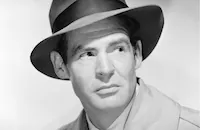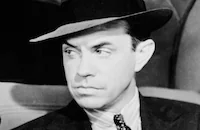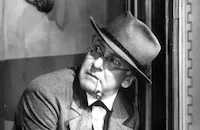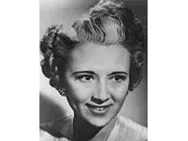The Woman on Pier 13

Brief Synopsis
Cast & Crew
Robert Stevenson
Laraine Day
Robert Ryan
John Agar
Thomas Gomez
Janis Carter
Film Details
Technical Specs

Synopsis
While on their honeymoon, Nan and Bradley Collins, who have known each other for only a week, run into Brad's former girl friend, fashion photographer Christine Norman. Still in love with Brad, Christine bristles with jealousy upon meeting Nan, and later confers with her Communist party cohort, J. T. Arnold, about Nan's background. Christine learns that Brad, the vice-president of San Francisco's Cornwall Shipping Company, has obtained a stevedore job for Nan's younger brother, Don Lowry. Cornwall Shipping is in the midst of a labor dispute, and president J. Francis Cornwall assigns the much-respected Brad, a former dock worker, to act as an intermediary between management and the union. Brad's new authority is endorsed by Jim Travers, the head of the union and Nan's recent ex-boyfriend. Before Brad can act on his assignment, however, he is visited by Vanning, a secretive Communist leader, who reminds Brad about his past as a Communist agitator named Frank Johnson. Annoyed, Brad goes to see Christine and declares that he has long since "graduated" from both her and the "party." Vanning counters Brad's defiance by ordering him to the party's dockside headquarters and threatening to expose him unless he donates two-fifths of his salary to the party. Vanning also forces Brad to witness the brutal drowning of Ralston, a party member suspected of being an FBI informant. Despite Vanning's vicious tactics, Brad announces that he is going to tell Nan and Cornwall the truth about his past. Producing a photostat copy of a party document written by Brad years before, in which Brad assumed responsibility for a killing that occurred during a walkout he orchestrated, Vanning effectively ends Brad's resistance. Faced with the prospect of a murder conviction, Brad agrees to help Vanning shut down the waterfront for sixty days by sabotaging the labor talks. The rebuffed Christine, meanwhile, pursues Don, much to Nan's dismay, and subtly draws him into her Communist circle. During the doomed labor meetings, Don loudly repeats the "party line," agitating his fellow workers, while Brad counsels management to reject all of labor's compromises. Finally, the negotiations are canceled, and the waterfront is shut down. Concerned about Christine's growing attachment to Don, the coldhearted Vanning demands that she break all ties with him. As Christine is about to leave for an assignment in Seattle, however, Don proposes marriage, and a conflicted Christine pledges her love. Sensing that Brad is in trouble, Nan, meanwhile, presses him to confide in her, but he denies any trouble. When Nan hears that Don has proposed to Christine, however, she confesses to Jim her apprehensions about the photographer, and Jim reveals that Christine is a Communist. Jim then accuses Don of being Christine's "stooge," and although he denies the charge, Don later asks Christine if Jim's allegations are true. While insisting that she truly loves him, Christine admits her Communist involvement to Don, but also implicates Brad in the conspiracy. Vanning overhears Christine and Don's conversation and, worried that Don will expose Brad, arranges for Don to be murdered by hired killers Bailey and Grip Wilson. Just after Christine telephones Nan to warn her about Don, Don is run down outside Nan and Brad's apartment. Although Brad tries to convince Nan that the death was accidental, Nan is suspicious and goes to see Christine. The grief-stricken Christine reveals that Don was indeed murdered, but also shows Nan a copy of Brad's party membership. With information provided by Christine, Nan finds the womanizing Bailey at the shooting gallery he operates and, while posing as an unhappily married rich woman, cajoles Bailey into revealing he is a hired killer. Vanning, meanwhile, forces Christine to write a suicide note and pushes her out of her apartment window, just as Brad arrives looking for Nan. Brad tries to retrace his wife's steps, but is waylaid by Grip, who has been notified by Vanning of Nan's activities. Eventually, however, Brad tracks Nan to the party warehouse, where she is about to be killed by Vanning. Brad bursts in on Vanning, brandishing a gun, but Vanning pulls out his own gun and tries to outdraw Brad. In the ensuing confusion, Brad and Nan escape and hide themselves in the warehouse. While exchanging gunshots with Vanning and his men, Brad apologizes to Nan for his past. Vanning finds Nan and is about to shoot her when Brad charges him. Brad manages to throw a grappling hook into Vanning, causing him to fall to his death, but is shot several times in the process. As a forgiving Nan holds him in her arms, Brad whispers that he met her too late and then dies.

Director

Robert Stevenson
Cast

Laraine Day

Robert Ryan

John Agar

Thomas Gomez

Janis Carter
Richard Rober

William Talman
Paul E. Burns

Paul Guilfoyle
G. Pat Collins
Fred Graham
Harry Cheshire
Jack Stoney
Lester Mathews
Marlo Dwyer

Erskine Sanford

Bess Flowers
Charles Cane
Dick Ryan
Barry Brooks
William Haade
John Duncan

Iris Adrian
Don Brodie
Al Murphy
Evelyn Ceder
Marie Voe
George Magrill
Louise Lane
Jim Nolan
Allan Ray
Crew
James Altwies
Robert Hardy Andrews
C. Bakaleinikoff
Charles Beckett
Fred Bentley
Phil Brigandi
Ralph Clement
Irving Cooper
Albert S. D'agostino
William Dorfman
George W. George
Larry Germain
Charles Grayson
Jack J. Gross
Roland Gross
Leigh Harline
Walter E. Keller
Gaston Longet
Nicholas Musuraca
W. H. Phillips
Clem Portman
Sid Rogell
Darrell Silvera
George F. Slavin
Michael Woulfe

Film Details
Technical Specs

Articles
The Woman on Pier 13 (aka I Married a Communist)
In form and style, The Woman on Pier 13 looked like a standard B-movie thriller with the shadowy texture and atmospheric lighting synonymous with the film noir visual aesthetics that RKO is known for. The storyline was a different matter, however, with dangerous Mafia-type villains replaced by life-threatening Soviet agents who were willing to blackmail, torture and kill for their cause. Their target is Brad Collins (Robert Ryan), a vice president for a San Francisco shipping company who has pulled himself up from the lowly rank of a longshoreman to become an influential executive. When the film opens, Brad has just returned from his whirlwind wedding to Nan (Laraine Day), who knows little of Brad's past life. Almost immediately a sense of paranoia sets in as Christine (Janis Carter), a former girlfriend of Brad's, mysteriously shows up on the scene. Her motives soon become clear as she tries to blackmail Ryan into returning to the Communist Party he had once been actively involved in as a disillusioned dock worker. When her tactics with Brad prove fruitless she goes after Nan's naive brother-in-law Don (John Agar) and begins influencing his political views. Meanwhile, Vanning (Thomas Gomez), the local Party boss, resorts to intimidation tactics and finally death threats to force Ryan to rejoin the Party and initiate a strike among the San Francisco dock workers, paralyzing the shipping companies.
Howard Hughes took a special interest in The Woman on Pier 13. Allegedly he used the film as a loyalty test for his employees. If any writer, director or actor who was assigned to work on it refused, they would be fired. The actual facts, however, indicate it was mainly frustration and creative differences that drove people off the project. At first John Cromwell was assigned to direct, working from a script by Herman Mankiewicz.
"After Hughes vetoed several script rewrites and various writers had departed," according to Franklin Jarlett (in his book Robert Ryan: A Biography and Critical Filmography), "Cromwell backed out of the film, calling the screenplay, "without a doubt the worst I have ever read in my life." Next, Nicholas Ray agreed to direct the film, but he also dropped out at the last minute. Finally, Robert Stevenson (Jane Eyre, 1944) took the helm, and I Married a Communist [as it was then called] went into production in April 1949. Principal shooting lasted one month, but two days of retakes were necessary after Hughes carefully examined and found fault with many aspects of the film. In one scene, Hughes ordered Laraine Day's profile to be reshot from a different angle when he noticed a blemish on her face. He criticized the kiss sequences between Janis Carter and John Agar, and wanted them to be made sexier. He also felt "very definitely" that "Bob Ryan and Bill Talman should be helped in their pistol shooting."
RKO executives had already polled audiences about their interest in a film titled I Married a Communist and the results were NOT promising. Hughes, however, was adamant at first about changing the name, stating, "This is ridiculous - I have always liked the title. In fact, the title is one of the most valuable parts of the picture." In time, he finally yielded to RKO executives and after considering titles like San Francisco Melodrama, Waterfront at Midnight and Where Danger Lives (which was later used for RKO's 1950 film noir starring Faith Domergue, a Hughes discovery), he settled on The Woman on Pier 13.
When the film was finally released in its re-edited, bowdlerized form, it still failed to generate any interest among moviegoers and was a certified box office bomb, ending up with a deficit of $650,000 in relation to its costs. Today, The Woman on Pier 13 is a fascinating and highly entertaining example of anti-communist agitprop, but audiences at the time didn't want to think about the communist menace. That's the main reason it was a commercial failure just as similar efforts such as My Son John (1952) - with Robert Walker as a secret commie agent - and Big Jim McLain (1952) starring John Wayne, were largely overlooked by the public.
In many ways, The Woman on Pier 13 is a true noir, however, with a protagonist who is destroyed by his reckless past, bringing scandal or death to those closest to him. The "Better Dead Than Red" sentiment was never expressed more explicitly than in this film and the hamfisted dialogue is message-mongering at its most extreme: "It's a pity that some of our members don't understand...they can never leave the Party...until the Party's ready to let them go."
Surprisingly enough, reviewers at the time were not as vocal about the film's rabidly anti-communist slant and in most cases singled out Robert Ryan's performance for praise. The New York Times review stated that "The Woman on Pier 13 is a right smart sampling of melodrama, fast paced and attractively padded with action and violence...Robert Ryan carries the story on his sturdy shoulders.." and Time magazine noted that "Robert Ryan's appearance in a film (Crossfire [1947], The Set-Up [1949]) has almost come to mean a low-budget picture with a future. He gives this movie some unexpected authenticity because he is capable of crossing black and white traits in a role, without showing his hands."
One final bit of trivia: The Woman on Pier 13 marked the film debut of character actor William Talman, who makes a memorable impression as Bailey, a sleazy carnival worker and hit man for the Party. He would later play the sociopath killer in Ida Lupino's thriller, The Hitch-Hiker (1953) but is best known for his TV appearances on Perry Mason as the title character's courtroom rival, Hamilton Burger.
Producer: Jack J. Gross, Sid Rogell
Director: Robert Stevenson
Screenplay: Robert Hardy Andrews, George W. George, Charles Grayson, George F. Slavin
Cinematography: Nicholas Musuraca
Film Editing: Roland Gross
Art Direction: Albert S. D'Agostino, Walter E. Keller
Music: Leigh Harline
Cast: Laraine Day (Nan Lowry Collins), Robert Ryan (Brad Collins), John Agar (Don Lowry), Thomas Gomez (Vanning), Janis Carter (Christine Norman), Richard Rober (Jim Travers).
BW-73m. Closed captioning.
by Jeff Stafford

The Woman on Pier 13 (aka I Married a Communist)
TCM Remembers - John Agar
Popular b-movie actor John Agar died April 7th at the age of 81. Agar is probably best known as the actor that married Shirley Temple in 1945 but he also appeared alongside John Wayne in several films. Agar soon became a fixture in such films as Tarantula (1955) and The Mole People (1956) and was a cult favorite ever since, something he took in good spirits and seemed to enjoy. In 1972, for instance, the fan magazine Famous Monsters of Filmland mistakenly ran his obituary, a piece that Agar would later happily autograph.
Agar was born January 31, 1921 in Chicago. He had been a sergeant in the Army Air Corps working as a physical trainer when he was hired in 1945 to escort 16-year-old Shirley Temple to a Hollywood party. Agar apparently knew Temple earlier since his sister was a classmate of Temple's. Despite the objections of Temple's mother the two became a couple and were married shortly after. Temple's producer David Selznick asked Agar if he wanted to act but he reportedly replied that one actor in the family was enough. Nevertheless, Selznick paid for acting lessons and signed Agar to a contract.
Agar's first film was the John Ford-directed Fort Apache (1948) also starring Temple. Agar and Temple also both appeared in Adventure in Baltimore (1949) and had a daughter in 1948 but were divorced the following year. Agar married again in 1951 which lasted until his wife's death in 2000. Agar worked in a string of Westerns and war films such as Sands of Iwo Jima (1949), Breakthrough (1950) and She Wore a Yellow Ribbon (1949). Later when pressed for money he began making the films that would establish his reputation beyond the gossip columns: Revenge of the Creature (1955), The Brain from Planet Arous (1957), Invisible Invaders (1959) and the mind-boggling Zontar, the Thing from Venus (1966). The roles became progressively smaller so Agar sold insurance and real estate on the side. When he appeared in the 1988 film Miracle Mile his dialogue supposedly included obscenities which Agar had always refused to use. He showed the director a way to do the scene without that language and that's how it was filmed.
By Lang Thompson
DUDLEY MOORE, 1935-2002
Award-winning actor, comedian and musician Dudley Moore died on March 27th at the age of 66. Moore first gained notice in his native England for ground-breaking stage and TV comedy before later building a Hollywood career. Like many of his peers, he had an amiable, open appeal that was balanced against a sharply satiric edge. Moore could play the confused innocent as well as the crafty schemer and tended to command attention wherever he appeared. Among his four marriages were two actresses: Tuesday Weld and Suzy Kendall.
Moore was born April 19, 1935 in London. As a child, he had a club foot later corrected by years of surgery that often left him recuperating in the hospital alongside critically wounded soldiers. Moore attended Oxford where he earned a degree in musical composition and met future collaborators Peter Cook, Jonathan Miller and Alan Bennett. The four formed the landmark comedy ensemble Beyond the Fringe. Though often merely labelled as a precursor to Monty Python's Flying Circus, Beyond the Fringe was instrumental in the marriage of the piercing, highly educated sense of humor cultivated by Oxbridge graduates to the modern mass media. In this case it was the revue stage and television where Beyond the Fringe first assaulted the astonished minds of Britons. Moore supplied the music and such songs as "The Sadder and Wiser Beaver," "Man Bites God" and "One Leg Too Few." (You can pick up a CD set with much of the stage show. Unfortunately for future historians the BBC commonly erased tapes at this period - why? - so many of the TV episodes are apparently gone forever.)
Moore's first feature film was the 1966 farce The Wrong Box (a Robert Louis Stevenson adaptation) but it was his collaboration with Peter Cook on Bedazzled (1967) that's endured. Unlike its tepid 2000 remake, the original Bedazzled is a wolverine-tough satire of mid-60s culture that hasn't aged a bit: viewers are still as likely to be appalled and entertained at the same time. Moore not only co-wrote the story with Cook but composed the score. Moore appeared in a few more films until starring in 10 (1979). Written and directed by Blake Edwards, this amiable comedy featured Moore (a last-minute replacement for George Segal) caught in a middle-aged crisis and proved popular with both audiences and critics. Moore's career took another turn when his role as a wealthy alcoholic who falls for the proverbial shop girl in Arthur (1981) snagged him an Oscar nomination as Best Actor and a Golden Globe win.
However Moore was never able to build on these successes. He starred in a passable remake of Preston Sturges' Unfaithfully Yours (1984), did another Blake Edwards romantic comedy of moderate interest called Micki + Maude (1984, also a Golden Globe winner for Moore), a misfired sequel to Arthur in 1988 and a few other little-seen films. The highlight of this period must certainly be the 1991 series Orchestra where Moore spars with the wonderfully crusty conductor Georg Solti and leads an orchestra of students in what's certainly some of the most delightful television ever made.
By Lang Thompson
TCM Remembers - John Agar
Quotes
Trivia
Notes
The working titles of this film were I Married a Communist and Beautiful But Dangerous. In October 1949, the picture had "test runs" in Los Angeles and San Francisco under the title I Married a Communist. In February 1948, Hollywood Reporter announced that Eagle-Lion had purchased an original screen story entitled "I Married a Communist" and had assigned the picture to producer Aubrey Schenck. In September 1948, however, RKO head Howard Hughes announced in Los Angeles Times that he was making the film. According to a June 1949 New York Times article, Art Cohn, James Edward Grant and credited writer Charles Grayson wrote the original drafts of the script, while Robert Hardy Andrews did the "final polish job." The exact nature of Cohn's and Grant's contribution to the final film has not been determined. The New York Times article also noted that for the rewrites, Andrews was instructed to remove any "soapboxing" from the story and delete all references to Russia, including Slavic-sounding names. The studio was also concerned about not sending an anti-labor message and consequently created the "Jim Travers" character, who is a sympathetic union leader, but a Communist detractor as well. A September 1948 Los Angeles Times article notes that George W. George, who is credited with the film's story, was a "well-known writer" working under a pseudonym. The writer's real name has not been discovered.
Contemporary news items add the following information about the film's production: At the time of Hughes's purchase of the story, Barbara Bel Geddes and Robert Young were announced as the stars, and John Cromwell, the director. Merle Oberon was then slated to star, and Cromwell was taken off as director. In late November 1948, Jane Greer was announced as a possible replacement for Oberon, but because of scheduling conflicts with The Big Steal , Hughes eventually pulled Greer from the part. Nicholas Ray was then assigned to direct, and Glenn Ford and Paul Lukas were announced as the film's male leads. In January 1949, production was delayed after Ford and Lukas both dropped out and were replaced by Robert Ryan and Thomas Gomez. RKO borrowed John Agar from David O. Selznick's company and Janis Carter from Columbia for the production.
Background shots were taken in San Francisco, CA. Following the test runs in San Francisco and Los Angeles, Hughes pulled the film from distribution because, despite its ad campaign, which tried to make clear that it wasn't a documentary, audiences were still perceiving it as such. To combat the misperception, Hughes temporarily renamed the film Beautiful But Dangerous, a title he purchased from Leon Gutterman. Many reviewers criticized the picture for depicting American Communists like Depression-era gangsters. The New York Times review also commented that if "Louis Budenz and Whittaker Chambers, among others, could renounce the party, why can't a movie hero do the same for once without having to shoot it out and be killed himself in the end?" According to modern sources, the film lost $650,000 at the box office.

Miscellaneous Notes
Released in United States 1995
Released in United States Summer June 3, 1950
Released in United States 1995 (Shown at AFI/Los Angeles International Film Festival (The AFI Fest Movie Marathon All Night: Left Wing versus Right Wing) October 19 - November 2, 1995.)
Released in United States Summer June 3, 1950














